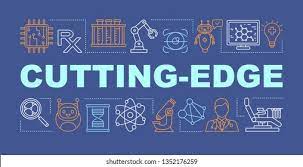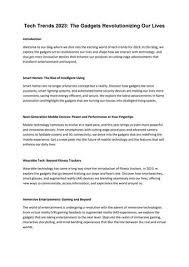Cutting Edge Technology: Shaping the Future
The world of technology is constantly evolving, with new advancements emerging at a rapid pace. Cutting edge technology refers to the latest and most advanced innovations that push the boundaries of what is possible. These technologies have the potential to transform industries, improve our daily lives, and address some of the most pressing challenges facing society today.
Artificial Intelligence and Machine Learning
Artificial Intelligence (AI) and Machine Learning (ML) are at the forefront of cutting edge technology. AI involves creating systems that can perform tasks that typically require human intelligence, such as visual perception, speech recognition, decision-making, and language translation. ML, a subset of AI, focuses on developing algorithms that enable computers to learn from data and improve their performance over time.
The applications of AI and ML are vast and varied. From healthcare diagnostics to autonomous vehicles, these technologies are revolutionising numerous fields. For instance, AI-powered diagnostic tools can analyse medical images with remarkable accuracy, aiding doctors in early detection of diseases like cancer. Similarly, self-driving cars leverage ML algorithms to navigate complex environments safely.
Blockchain Technology
Blockchain technology is another groundbreaking innovation that has garnered significant attention in recent years. A blockchain is a decentralised digital ledger that records transactions across multiple computers in a secure and transparent manner. This technology underpins cryptocurrencies like Bitcoin but has far-reaching applications beyond digital currencies.
One notable application of blockchain is in supply chain management. By providing an immutable record of transactions, blockchain can enhance transparency and traceability in supply chains, reducing fraud and ensuring product authenticity. Additionally, blockchain-based smart contracts automate contract execution when predefined conditions are met, streamlining processes and reducing administrative costs.
Quantum Computing
Quantum computing represents a paradigm shift in computational power. Unlike classical computers that use bits as the smallest unit of information (represented as 0 or 1), quantum computers use quantum bits or qubits. Qubits can exist in multiple states simultaneously thanks to the principles of quantum superposition and entanglement.
This unique property allows quantum computers to solve complex problems exponentially faster than their classical counterparts. While still in its nascent stages, quantum computing holds promise for breakthroughs in fields such as cryptography, material science, drug discovery, and optimisation problems.
5G Technology
The rollout of 5G networks marks a significant milestone in telecommunications. 5G technology offers unprecedented speed and connectivity compared to previous generations of mobile networks. With ultra-low latency and high data transfer rates, 5G enables real-time communication between devices on an unprecedented scale.
This enhanced connectivity paves the way for innovations like the Internet of Things (IoT), where interconnected devices communicate seamlessly to create smart homes, cities, and industries. For example, 5G can support autonomous industrial robots working collaboratively on manufacturing floors or enable remote surgeries with minimal delay.
Sustainable Technologies
Sustainability is becoming increasingly important as we face environmental challenges such as climate change and resource depletion. Cutting edge sustainable technologies aim to mitigate these issues by promoting energy efficiency and reducing carbon footprints.
Renewable energy sources like solar power have seen significant advancements through improved photovoltaic cells that convert sunlight into electricity more efficiently than ever before. Additionally, innovations in battery storage solutions are making it possible to store renewable energy for use during periods when generation is low.
The Future Awaits
The impact of cutting edge technology cannot be overstated; it shapes our future by driving progress across various domains while addressing critical global challenges head-on.
As we continue exploring these technological frontiers together – whether through AI breakthroughs or sustainable innovations – one thing remains clear: The future holds boundless possibilities driven by human ingenuity harnessed through cutting-edge tech advancements!
Top 5 Benefits of Cutting-Edge Technology: Efficiency, Innovation, and Beyond
- Enhanced Efficiency
- Innovative Solutions
- Improved User Experience
- Competitive Advantage
- Societal Impact
Challenges of Cutting-Edge Technology: Privacy, Costs, Job Disruption, Cybersecurity, and Inequality
- 1. Privacy Concerns
- 2. Costly Implementation
- 3. Disruption of Job Markets
- 4. Cybersecurity Risks
- 5. Technological Inequality
Enhanced Efficiency
Enhanced Efficiency is a key advantage of cutting edge technology, as it streamlines processes and tasks, ultimately boosting productivity and lowering operational costs. By leveraging the latest innovations such as automation, artificial intelligence, and data analytics, organisations can optimise workflows, eliminate manual errors, and accelerate decision-making. This increased efficiency not only allows businesses to accomplish more in less time but also enables them to allocate resources more effectively, leading to significant cost savings in the long run. The ability of cutting edge technology to enhance efficiency is a game-changer for modern enterprises striving to stay competitive in today’s fast-paced digital landscape.
Innovative Solutions
Cutting edge technology paves the way for innovative solutions that address complex problems with creativity and novelty. By leveraging advanced tools and methodologies, these technologies enable industries to overcome challenges that were previously insurmountable. For instance, in healthcare, AI-driven diagnostic systems can identify diseases at an early stage with remarkable accuracy, while blockchain technology enhances transparency and security in financial transactions. In manufacturing, 3D printing allows for rapid prototyping and customisation, reducing time-to-market for new products. Such innovations not only streamline processes but also open up new avenues for growth and development across various sectors, ultimately fostering a culture of continuous improvement and ingenuity.
Improved User Experience
Cutting edge technology significantly enhances user experiences by offering seamless interactions and personalised services. Advanced algorithms and AI-driven systems can analyse user behaviour and preferences, enabling the creation of tailored content and recommendations that meet individual needs. This level of personalisation ensures that users receive relevant information and services, making their interactions more efficient and enjoyable. Additionally, intuitive interfaces and responsive designs powered by the latest tech innovations facilitate smooth navigation and reduce friction points, ultimately leading to higher user satisfaction and engagement.
Competitive Advantage
Embracing cutting edge technology provides companies with a significant competitive advantage by positioning them ahead of the competition and enabling them to adapt to changing consumer preferences. By leveraging the latest innovations, businesses can enhance their products and services, streamline operations, and deliver more personalised experiences to their customers. This proactive approach not only fosters growth and profitability but also strengthens brand reputation and customer loyalty in a dynamic market landscape. In essence, staying at the forefront of technological advancements empowers companies to anticipate trends, meet evolving consumer demands, and maintain a competitive edge in today’s fast-paced business environment.
Societal Impact
Advancements in cutting edge technology hold immense promise in addressing societal challenges, enhancing quality of life, and fostering positive change. From AI-driven healthcare solutions that enable early disease detection to blockchain applications that enhance transparency in supply chains, these innovations have the power to revolutionise how we tackle pressing issues. By harnessing the potential of cutting edge technology, we can create a more sustainable, connected, and equitable society where opportunities for progress and improvement abound.
1. Privacy Concerns
Privacy concerns are a significant con associated with cutting edge technology. The advancements in technology have enabled extensive data collection and surveillance capabilities, raising questions about the protection of personal information and individual privacy. From facial recognition systems to targeted advertising algorithms, the use of cutting edge technology can lead to the potential misuse or exploitation of sensitive data. As our digital footprint expands, it becomes increasingly challenging to maintain control over our personal information, highlighting the importance of robust privacy regulations and ethical guidelines in the rapidly evolving technological landscape.
2. Costly Implementation
Implementing cutting edge technology often comes with a notable drawback: the high cost involved. Embracing these advanced solutions can be financially demanding, as it necessitates substantial investments in infrastructure upgrades and employee training. Companies and organisations considering the adoption of cutting edge technology must carefully weigh the financial implications and assess whether the long-term benefits outweigh the initial expenses. The costly implementation of such technologies may pose a barrier for smaller businesses or institutions with limited budgets, potentially widening the digital divide between industry leaders and those struggling to keep up with technological advancements.
3. Disruption of Job Markets
One significant con of cutting edge technology is the disruption it brings to job markets. Automation driven by advanced technologies, such as artificial intelligence and robotics, has the potential to replace human workers in various industries, leading to job displacement and shifts in the labour market landscape. As machines become increasingly capable of performing tasks traditionally done by humans, there is a concern that certain jobs may become obsolete, requiring workers to adapt to new roles or face unemployment. This disruption poses challenges for individuals and societies as they navigate the impact of technological advancements on employment opportunities and economic stability.
4. Cybersecurity Risks
Sophisticated technologies, while offering immense benefits, also come with inherent risks, particularly in the realm of cybersecurity. As cutting edge technology advances, so do the capabilities of cyber threats. The complexity of these technologies makes them susceptible to cyber attacks, leading to potential data breaches and system vulnerabilities. Safeguarding sensitive information and ensuring the integrity of digital systems become critical challenges in an era where cyber threats are becoming increasingly sophisticated and pervasive. Organizations and individuals must remain vigilant and proactive in implementing robust cybersecurity measures to mitigate these risks effectively.
5. Technological Inequality
Technological Inequality poses a significant con of cutting-edge technology. While advancements in technology have the potential to improve lives and drive progress, they also risk widening the digital divide. Access to cutting-edge technology may not be equitable, leading to disparities in opportunities and resources among different socio-economic groups. Those who lack access to the latest innovations may find themselves at a disadvantage in education, employment, and overall quality of life. Addressing technological inequality is crucial to ensure that the benefits of cutting-edge technology are accessible to all, regardless of their background or circumstances.



